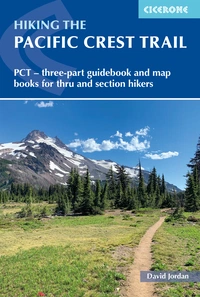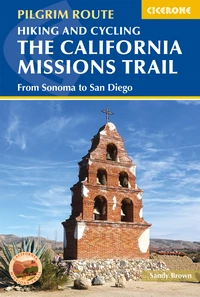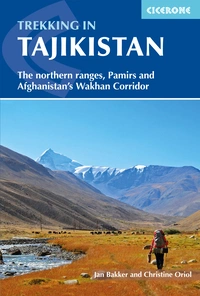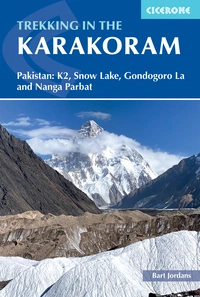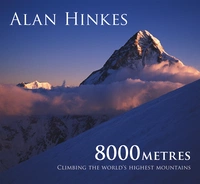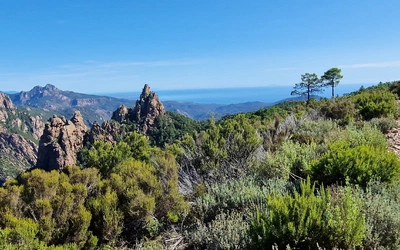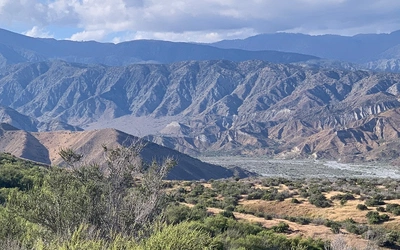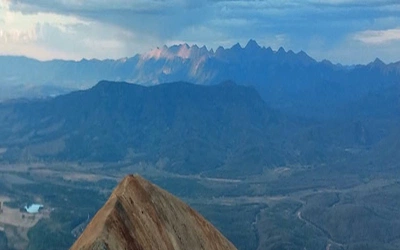PCT experience: what it’s like to hike the Pacific Crest Trail
We sat down with David Jordan to chat about his experience hiking the Pacific Crest Trail, one of the most iconic long-distance hikes in the world. David shared his insights on the challenges and rewards of the journey, from navigating the varying landscapes and river crossings to the emotional and physical resilience required. He also offered valuable tips for anyone planning to take on the PCT, including preparing for different terrains, the importance of pacing yourself, and handling resupply logistics. Read on to discover David’s reflections on this incredible trail and his advice for making the PCT adventure a life-changing experience.
Hiking the Pacific Crest Trail
PCT - three-part guidebook and map books for thru and section hikers
£34.95
SALE
£29.71
Three-book guidebook set to the Pacific Crest Trail (PCT), an epic 2650-mile hike from the Southern Terminus at California's Mexican border to the northern Terminus at the Canadian border. Designed to be compact and lightweight the set is separated into three books, an introduction to the trail and two map books.
More information
Hi David, it sounds like you had an amazing experience on the trail. What drew you to hiking the PCT?
I have a deep-rooted need to wander, and throughout my early years of incarceration in corporate life, I spent many a happy commute reading travel and hiking stories. I’d loosely followed people hiking the Appalachian Trail (AT) for many years and undertaken a few sections myself, then stumbled across the PCT in the years before it was so widely known. I was instantly hooked. The variety of landscapes, the scale of the mountains, the challenge of river crossings, and the remoteness in the north all lured me in. It became an obsession, and I consumed everything I could about the trail for years before life presented me with a crossroads where I could legitimately justify the time away from home and work.
Can you give us a brief overview of your experience on the trail?
I've completed two thru-hikes of the Pacific Crest Trail (PCT) in 2016 and 2023, both starting at the southern terminus in mid-April (the 16th and the 22nd) and heading north.
However, in 2023, the heavy snowpack lingering in the Sierra Nevada made conditions particularly challenging, with dangerous river crossings. To adapt, I turned my hike into a flip-flop, skipping ahead to hike a northern section first and then returning later to complete the Sierra. In 2016, I finished at the northern terminus on 31st September. In 2023, I completed my hike southbound, finishing at Kennedy Meadows at the base of the Sierra on 23rd September.
The first hike included 18 full zero days (rest days where zero miles are covered on the trail) — many due to a hiking partner’s worsening foot injury. By contrast, my second hike had only 11 zero days, despite the extra travel involved in the flip-flop. The two experiences felt quite different. Some of that was because I knew what to expect, but the trail itself had also changed. Reduced trail maintenance during the COVID years, combined with the record-breaking snowfall of winter 2022/23, left the trail feeling wilder and more challenging than before.
That said, both hikes were equally thrilling and deeply soothing. There’s something truly restorative about spending that much time outdoors, immersed in the natural world. It's an experience that’s hard to put into words.
How fit were you before starting, and had you done any long-distance trekking?
I’d been a regular hiker and backpacker for many years, having undertaken trips in the Pennines, Lakes and across Scotland from coast to coast, as well as in the Alps, including the Tour du Mont Blanc. Despite that experience, I left for both PCT trips decidedly unfit. An intense job role prior to 2016 meant I had done little training prior to departure, and in 2023 I was getting over almost 18 months of long-covid illness. Neither situation was ideal, but I knew I could pace myself, and that in as little as a couple of weeks, my body would start to respond.
How was the planning process?
Planning a trip is half the fun. I studied other hikers’ kit lists and post-trail reports to refine my kit and to consider how best to approach resupply. There’s lots of material out there to use when thinking about where to buy and send food ahead. With more small stores close to the trail now trying to stock items hikers want, it’s now almost possible to hike the whole way without sending any food parcels ahead. However, that does rely on there being stock when you arrive, so try to avoid being a few days behind a large ‘bubble’ of other hikers or you might find they’ve cleared the shelves ahead of your arrival!
What was a typical day like on the trail?
Once I’d got into the rhythm of hiking and developed sufficient fitness, I would prefer to start early in the mornings, particularly in the desert and during mid-summer when temperatures can rise quickly. I’d be up and packed in 30 minutes from my alarm and hiking by 6am.
I would typically hike at around 2.5mph, so, provided I could eat breakfast (a couple of bars usually) ‘on the go’, most days I could hike 10 miles by 10am. I’d sometimes meet others and want to stop and chat, but on the whole I preferred to keep fairly disciplined and get the miles under my belt while the day was still cool. Those first 10 miles were always celebrated with a rest and ‘second breakfast’ (oatmeal, a cookie/bar/M&Ms or any other goodies floating around in the food bag), hanging out for around 30 mins, and ideally having bumped into another hiker for a bit of social time.
Now a little slower, I’d hike on until around 2pm or a bit longer to see if I came across anyone, or to reach a water or shade source, then break for a long lunch. On hot days, this could be up to a couple of hours. If I’d managed to pick any up, water would be supplemented with electrolyte powders with exotic flavours such as watermelon. Lunch might typically be a wrap, with cheese spread, nuts, dried fruit, maybe some chips (crisps), and usually some form of chocolate, carefully retrieved from deep in the pack to minimise melting. My trail shoes and socks would be off as soon as I stopped and my feet aired, an important ritual to minimise blisters and to remove the dust and debris that cause them.
Late afternoon would often still be hot, and how much further I would hike would depend on the next possible tent site, water source and anyone I wanted to catch up with to camp. It would not be uncommon to discuss a target campsite with anyone friendly that you’ve got to know a little and to loosely aim to end up in the same place for the night.
How many hikers did you meet along the way?
I met plenty of hikers – both thru-hikers and people doing smaller sections or day hikes, especially near trailheads. The PCT has a great mix of US and international hikers, making it easy to meet like-minded people. Romance is even possible – some close friends of mine from different countries met on the trail and got married a year later, even having their wedding ceremony on the trail!
If you stay outside the main hiker bubble, it’s still possible to hike alone or go a day or two without seeing anyone. However, most days, you’ll pass or see at least a few other people, especially in the southern sections where the number of hikers on the trail tends to be higher.
What food did you eat?
Noodles – lots of noodles – and couscous were staples. Long trail diets often get a bad rap for being full of sugar and processed foods, but it doesn't have to be all bad. While there are plenty of sugary treats at gas stations and small stores, I managed to keep things reasonably balanced. My dinners usually consisted of a carb base like rice, noodles, or couscous, supplemented with dried vegetables and something like tuna or mackerel in foil pouches or summer sausage. I always had some dried fruit each day.For snacks, I ate a lot of nut and seed trail mix, and breakfast was typically an oats/granola mix, depending on what I could find in small stores. I also carried protein bars and indulged in sweet treats like Snickers and M&Ms because, honestly, if you can’t enjoy those while hiking miles a day, when can you?Whenever possible at resupply stops, I’d treat myself to fresh produce, salad, and fruit to boost my vitamin intake. Supermarket deli counters are a great budget-friendly option for that.
What gear did you take?
I’ve become pretty good at keeping my kit minimal, but I wouldn’t quite classify myself as ‘ultralight.’ My big three – pack, tent, and sleeping bag/system – were all middle-of-the-road, light-ish options that didn’t break the bank. I hiked in shorts 90% of the time but carried a lightweight pair of long pants for cooler moments, which also worked as a sleep layer on cold nights. In 2023, I tried a sun hoodie for the first time instead of a regular hiking shirt and loved it. The long sleeves and thumb loops meant I could ditch the sun gloves I’d used, especially in the desert and at high altitudes where my hands were prone to burning while using trekking poles. In 2016, I used a small gas canister stove for the whole route, but in 2023, I tried cold soaking food for most of the hike and found it worked well. I did bring back the stove for the last month when it got colder – nothing beats a hot chocolate before bed! One thing I regretted was forgetting snow baskets for my trekking poles. When I realised I needed them, every store I went to was sold out, as many others had the same idea. On a positive note, my GPS watch was incredibly useful for tracking my average hiking speed, making it easier to estimate how far I could go each day.
Any safety aspects to be aware of?
There’s often a lot of anxiety about safety, especially early on, but most risks can be easily managed with some basic precautions. Here are the key things to be aware of:
- Bears and animals: Always keep food and anything with a scent sealed properly to avoid attracting bears, rodents, or insects.
- Lightning: Avoid crossing high passes or open ground during storms when lightning is a risk.
- Hitchhiking: If you feel uncomfortable with a ride, trust your instincts – pass it up or wait for another hiker to join you.
- Wildfires: The forest service and authorities quickly act when wildfires are reported, and they’ll close sections as needed. There’s plenty of advice available to help you avoid danger, but always stay informed.
- River crossings: Take these seriously – don’t risk it. If the water is fast-flowing and knee-deep or higher, find a safer crossing, such as further upstream for a narrower point, or look for slower water downstream. Be careful with log crossings – make sure branches can’t trap you if you slip. If necessary, wait until morning when the flow may have reduced due to less snowmelt.
The biggest risk to hikers is usually themselves. Take care: don’t jump off or onto anything, slow down on narrow or exposed paths, and always look after your body. Avoid illness by maintaining hygiene – these are the most common causes of hikes ending early.
What surprised you the most about the trail?
The small things – the tiny creatures and plants that carve out a life in wildly varied and precarious places. Having the time to notice these things (and be in the places to do so) is a real privilege. Also, despite the cultural differences among the people I met, it’s hard not to notice that there’s real friendliness and acceptance among the hiking community. They are the coolest people on earth!
What is the most difficult part of the trail?
The hiking can be tough, but you quickly adapt to it. There’s no one harder part of the trail, but each area can have particular challenges that can be difficult, lack of water, sun exposure and deep snow are all hard. In ’23, long sections of late-lying snow were challenging, especially over Mt San Jacinto. There was also significant tree fall from avalanche and snow weight damage, particularly in north California and Oregon, which meant climbing under, over or through downed trees and scrub for long sections.
What was your favourite part of the trail?
There are so many that this is hard to answer. Goat Rocks Wilderness in Washington is beautiful and dramatic; Carson Pass is a highlight, too; the wildflower variety there is spectacular. Climbing up to the slopes of Mt Adams from Trout Lake is thrilling, and you really feel like you are entering the remotest areas of the trail. Further south the Sierra Nevada section is stunningly beautiful, but beyond that Desolation Wilderness is also really special. Perhaps my ultimate favourite, though, is a short section of grassy rolling hills dotted with oak trees in the Lake Hughes area, just before dropping down to the crossing of the corner of the Mojave Desert. The trail is full of surprises like this.
How would you describe the PCT in three words?
- Captivating
- Demanding
- Rewarding
Would you do the trail again? If so, what would you do differently?
Yes – I would like to section hike the trail. There’s so much to see and enjoy, and while a thru-hike is satisfying, a series of section hikes would enable me to explore more around the trail itself.
What advice or encouragement do you have for people?
It is easy to think you can’t hike the trail for many reasons. If you’re unsure, set some small goals, such as a weekend backpack trip, then four days, increase the distance, and build confidence. Everyone has doubts, but overcoming them is a deeply satisfying process.
Any final thoughts?
It’s a cliché, but it really is the journey that counts. Don’t place too much on achieving an end-to-end continuous hike. So much can get in the way, including time, fire closures, injury, family crises, budget challenges and so on. Go into the adventure with an open mind and accept what it offers you with gratitude. I've put together an A to Z of the PCT highlights below.
Thank you!
The PCT from A to Z
Angels – Trail angels are strangers who go out of their way to help you without reward.
Bubble – The bubble is the large number of northbounders following the ‘classic’ schedule (May to September), making the trail and towns appear busy with hikers.
Campgrounds – From primitive backcountry sites to full amenities, these usually require a fee, whereas simple tent sites are free and plentiful.
Dirt – Something to get used to! You’ll camp on it, sit in it and invariably wear it, until the occasional and wonderful shower opportunity.
Experience – Some prior experience is helpful but not essential. Once you’re out there, ensure you make it the experience YOU want, whether that’s a lively ‘family’ (see below) with lots of town visits or wilderness solitude to reflect and grow.
Flip-flop – Jumping ahead to do a section of trail, then returning later to do the current section (a great way to avoid the bubble).
Gas – Gas for stoves is available in most small stores near the trail. It’s worth noting that you can’t post gas ahead.
Hitching – It is reasonably easy and safe near the trail where residents are familiar with hikers but always reject a ride if something feels off. Another will come along.
Insects – It’s rare to have a problem with spiders and such, but be sensible, check your shoes, and don’t stick your fingers in holes. Mosquitos are only challenging for a couple of weeks after the snow melts.
John Muir – A Scottish emigrant to the US who subsequently advocated for conserving and protecting the land that makes up the Sierra Nevada range.
Kennedy Meadows – A community and major milestone at the southern end of the Sierra Nevada range. However, a second ‘Kennedy Meadows’ with the suffix ‘North’ is a short way from Sonora Pass.
Leave No Trace (LNT) – an important principle for hikers to protect the places we love and ensure others enjoy the same experience.
Magic – When ‘the trail provides’ the serendipity of what you need most, coming along when you least expect it!
Nero – Not quite a day off, but a day with only a few miles walked, usually coinciding with a resupply trip to a nearby community store or small town.
Off Trail Miles – These are the ‘extra’ necessary miles you’ll cover to get from the trail to sources of resupply and back. They can really add up.
Pooping – Pooping in the backcountry is something you’ll get used to. Take the time to find ground in which you can dig a good hole so that others, or animals, don’t uncover your waste.
Quests – Part of trail culture, these ‘challenges’ get passed through the trail community and from year to year, including stunts such as the ‘24-hour challenge’. Sometimes fun, but not always sensible.
Rivers – You’ll cross many without bridges. A few can be dangerous, but there’s always an alternative, even if that means going a long way upstream or waiting until the morning when levels drop due to reduced overnight snowmelt.
Sobo - ‘South-bound’, a less traditional way of completing the trail compared to north-bound (Nobo).
Tramily – It is common for hikers on a similar schedule to form loose ‘trail families’, who generally camp and resupply together, even if they often hike at their own pace.
Umbrellas – Surprisingly useful in the desert where the heat can be relentless and the shade sparse. Good for rain, too, but a pain in any wind.
Volunteers – The whole PCT experience relies on hundreds of often unseen volunteers who give up time to maintain the trail, support the work of the PCT Association, organise rides, and countless other acts of kindness that make the trail what it is.
Water Report – The essential resource for live updates and crucial information about water sources, fire risk and snow. This is crowd-sourced, so consider contributing too.
Xenophile – Anyone who loves strangers and foreigners. The PCT is a very international community each year, and it’s a great way to meet people from all over the world.
Yellow-legged mountain frog – Once common, this now endangered species is protected by the 3.6mi Williamson Rock trail closure that has been in place for many years. It typically requires a lengthy detour.
Zero – A rest day with no trail miles walked. If taken in town, however, you can still walk considerable ‘town miles’ between stores, post office, etc.
Hiking the Pacific Crest Trail
PCT - three-part guidebook and map books for thru and section hikers
£34.95
SALE
£29.71
Three-book guidebook set to the Pacific Crest Trail (PCT), an epic 2650-mile hike from the Southern Terminus at California's Mexican border to the northern Terminus at the Canadian border. Designed to be compact and lightweight the set is separated into three books, an introduction to the trail and two map books.
More information
